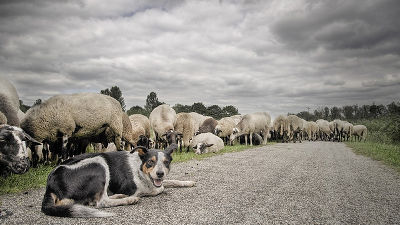A flock of sheep acquires collective intelligence by changing the leader who leads the collective action in a short time.

Sheep tend to herd and often move in groups rather than individually. Until now, it was thought that a flock of sheep basically only moved while following the leading sheep. Research results have been announced that collective intelligence is obtained by sharing knowledge throughout the herd.
Intermittent collective motion in sheep results from alternating the role of leader and follower | Nature Physics
https://doi.org/10.1038/s41567-022-01769-8
Physics study shows that sheep flocks alternate their leader and achieve collective intelligence
https://phys.org/news/2022-11-physics-sheep-flocks-alternate-leader.html
The research results were presented by Luis Gómez-Nava, who studies modeling of biological systems at Humboldt University, Richard Bon, who studies animal behavior at the University of Toulouse, and sociobiology at the University of Cote d'Azur. My name is Fernando Peruani.
Collective behavior in which animals move as a whole herd is never continuous. For example, an entire herd may stop to rest or feed, interrupting collective behavior. However, previous studies dealing with collective behavior of animals assumed ``collective behavior that continues to move from beginning to end'', and ``collective behavior of a group is based on the direction in which each individual moves. Peruani points out that it was thought that we were always discussing and progressing.
Peruani et al. considered that ``collective behavior is intermittent with some kind of beginning and end,'' and observed the collective behavior of small flocks of sheep in detail at different time intervals. We evaluated the correlation with migration speed while analyzing the movements of individual sheep flocks. As a result, it was found that the observed herd movements did not match existing models and extended models of herd movements.

Furthermore, when analyzing how information is transmitted in the herd, it was found that the communication network representing the behavior of the herd is highly hierarchical. In other words, rather than information being vaguely exchanged among sheep, a network was formed in which one animal that received information conveys information to multiple sheep belonging to the same community.
Furthermore, it also became clear that the information transmitted through this network was only related to the position of the sheep within the group. Also, from the results of the experiment, Peruani et al.
'The important thing is that at each stage of collective action in the flock, there is a temporary leader sheep,' Peruani said. Sheep act together using a hierarchical communication network, delegating full authority for collective action to a leader, but this leader is a temporary position that is frequently replaced and soon another sheep takes over. that's right.
For example, if one sheep has knowledge such as the route to go in the flock and the location of food, the whole flock can move efficiently if that sheep acts as a leader. However, the sheep does not act as a leader consistently from the beginning to the end, but only temporarily leads the flock in collective action. By repeating how individual sheep become leaders and followers in this way, the knowledge possessed by individual sheep is shared by the entire flock and collective intelligence is acquired.

The research team argues that the findings suggest that naturally occurring animal population strategies may operate in a hierarchical and democratic manner.
Peruani and colleagues work with groups of lambs, young sheep, and adult sheep to examine how temporary leader information is shared within the community and how the herd distributes and processes information. It is said that they are comparing In addition, assuming the possibility of causing conflicts of interest within the herd in a maze or a large space, it seems that they are investigating in detail how the entire herd behaves.
Related Posts:







